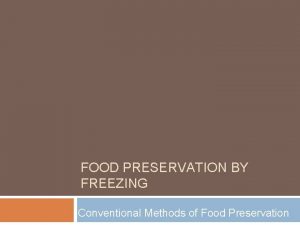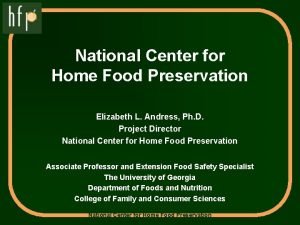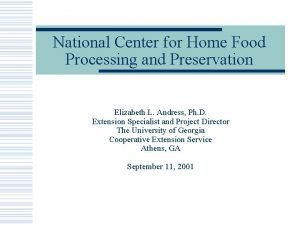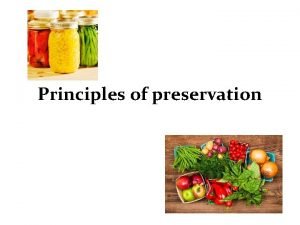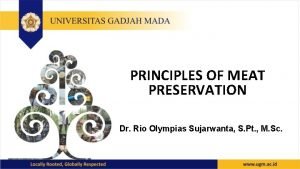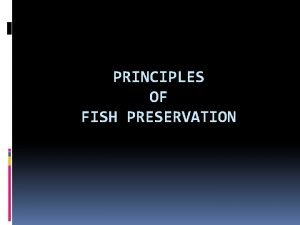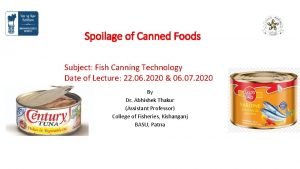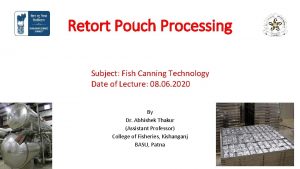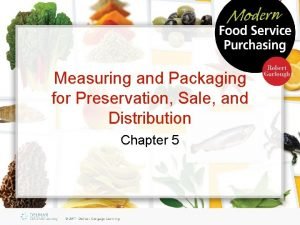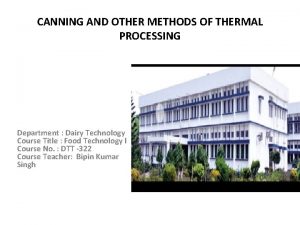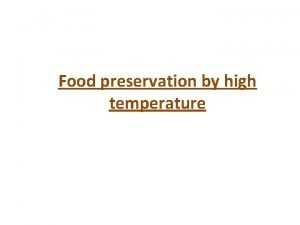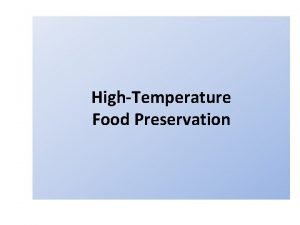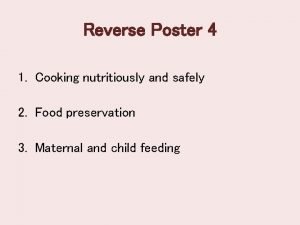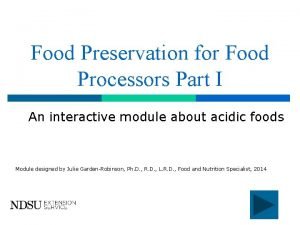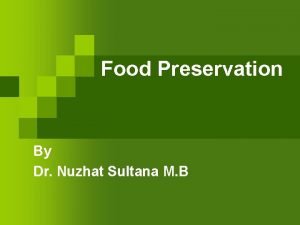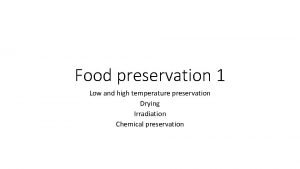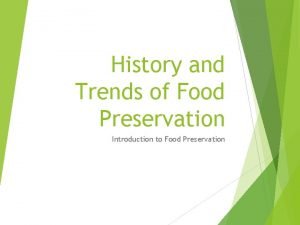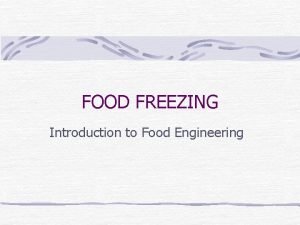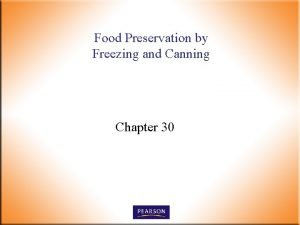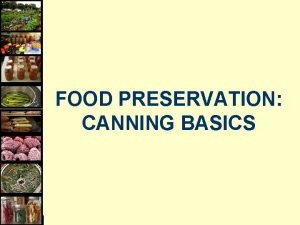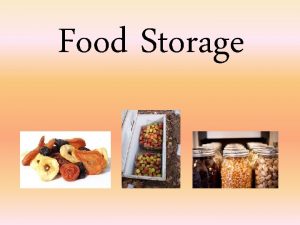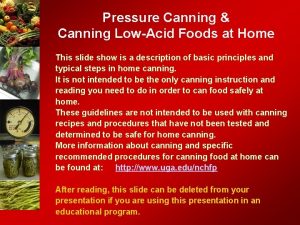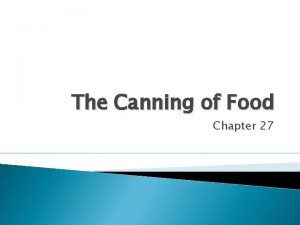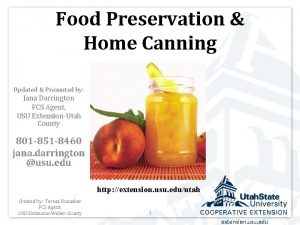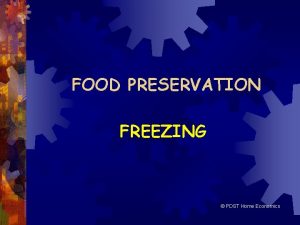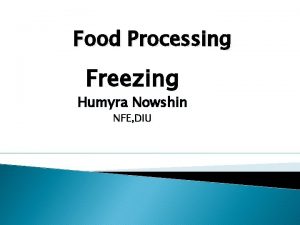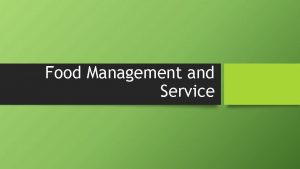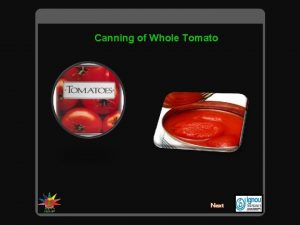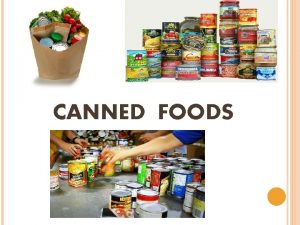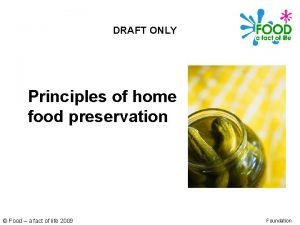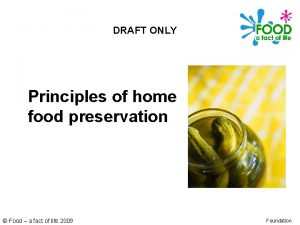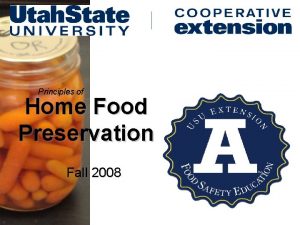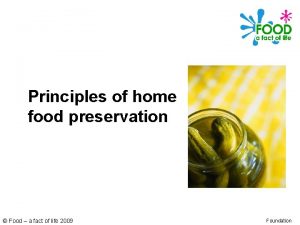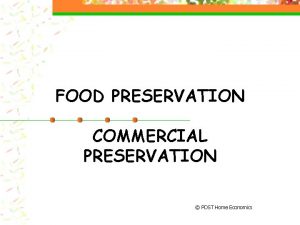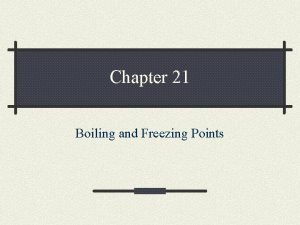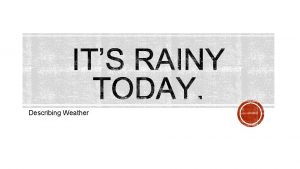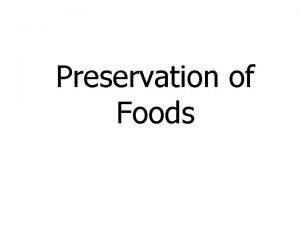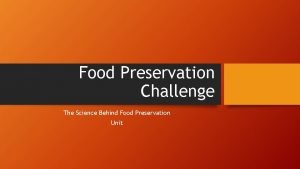Principles of Home Food Preservation Freezing Dehydrating Canning





























- Slides: 29

Principles of Home Food Preservation

• Freezing • Dehydrating • Canning • • Boiling water canning Pressure canning Pickling Jams & Jellies http: //homefoodpreservation. usu. edu Food Preservation 2

Food Safety No. 1 Priority • USDA Complete Guide to Canning • USU Fact Sheets • NCHFP • Ball Blue Book http: //homefoodpreservation. usu. edu • Use only research tested recipes 3

• Yeast • Molds • Bacteria • Enzymes http: //homefoodpreservation. usu. edu Why foods spoil 4

• Processing temperature • Processing time • Sealed lid http: //homefoodpreservation. usu. edu Safe Canning 5

• Acid level • Container & size • Preparation method • Consistency of food • Altitude • Research http: //homefoodpreservation. usu. edu Determining Safe Processing 6

• p. H 4. 6. or lower = acid food = BWC processing • p. H above 4. 6 = low acid food = pressure processing • Why? – botulism! http: //homefoodpreservation. usu. edu Acid Level 7

• p. H 4. 6. or lower • Use Boiling water canner • Temperature reaches 200 -212ºF • Tomatoes, jams, fruits, BBQ sauce, http: //homefoodpreservation. usu. edu High Acid Foods 8

• p. H above 4. 6. • Use Pressure canner • Temperature reaches 240 -250ºF • Vegetables, meat, soups, etc. http: //homefoodpreservation. usu. edu Low Acid Foods 9

• Mason jars best choice • 4, 8, 16, and 32 oz. common • 64 oz. only for juice • Mayo jars okay • 2 -piece metal lids http: //homefoodpreservation. usu. edu Containers 10

http: //homefoodpreservation. usu. edu Raw Pack & Hot Pack 11

Disadvantages: • Floating food • Air bubbles • Discoloration over time • Texture loss http: //homefoodpreservation. usu. edu Raw Pack & Hot Pack 12

• Always use new lids • Hand tighten • Too loose (leaks) • Too tight (no vacuum) http: //homefoodpreservation. usu. edu 2 Piece Metal Lids 13

• Remove air bubbles • Wipe rim • Preheat lid (soften sealing compound) • Attach lid • After processing hear seal “pop” remove screw band http: //homefoodpreservation. usu. edu Sealing 14

• Affects heat penetration • Liquid always required • Reason some foods cannot be canned --cubes vs slices --pumpkin butter --no added thickeners --no pasta or noodles http: //homefoodpreservation. usu. edu Consistency of Food 15

Altitude (in feet) Temperature when water boils 10, 000 194°F 8, 000 197°F 6, 000 201°F 4, 000 204°F 2, 000 208°F 0 (Sea Level) 212°F http: //homefoodpreservation. usu. edu • Affects temperature reached when boiling • It is temp. reached and not the action of boiling that kills microorganisms • Higher altitudes need longer boiling water time or higher pressures in pressure canner • Always use tested recipe/process 16

• Low quality foods make low quality preserves • Always preserve the freshest foods (within hours of harvest) • Before canning: -- Some fruits may be allowed to fully ripen off the vine -- Some meats may be refrigerated for 1 -2 days http: //homefoodpreservation. usu. edu When to can 17

• Wash jars before every use in clean soapy water • Rinse well • Sterilize jars and lids in boiling water only when boiling water canning less than 10 minutes http: //homefoodpreservation. usu. edu Preparing Jars 18

• Aluminum or porcelaincovered steel • Flat bottom • Not more than 2” wider than burner • Jar rack or bottom rack needed • Steam canners not recommended http: //homefoodpreservation. usu. edu Boiling Water Canner 19

Boiling Water Canning Fill canner halfway with water. Preheat to 140°F for raw pack and 180°F for hot packed foods. Load filled jars with lids into rack and then lower into water. Add more boiling water to cover jars at least 1 inch. Turn heat to highest setting until water boils vigorously. Start timer once water boils vigorously. http: //homefoodpreservation. usu. edu 1. 2. 3. 4. 5. 6. 20

7. 8. 9. 10. Cover and turn down heat until gently boiling. Add more boiling water as needed. When time is up turn off heat and remove lid. Remove from canner and set on a towel at least 1 inch apart to cool. 11. After lids seal (pop) remove screw bands. http: //homefoodpreservation. usu. edu Boiling Water Canning 21

• Aluminum or steel • Lid with gasket • Flat or concave bottom • Weighted or dial gauge (check dial gauge annually) • Pressure safety valve • Jar rack http: //homefoodpreservation. usu. edu Pressure Canner 22

Pressure Canning http: //homefoodpreservation. usu. edu 1. Put 2 -3 inches of water in canner, lower rack of filled and lidded jars into canner and fasten cover securely. 2. Heat until steam escapes from vent port. 3. Let steam vent for 10 minutes, then place weight on vent port or close petcock. Allow to pressurize. 4. Begin to time when recommended pressure is reached. 5. Adjust heat to regulate a steady pressure on gauge. 23

Pressure Canning http: //homefoodpreservation. usu. edu 6. If pressure drops below required amount, reset time to zero. 7. When time is completed, turn off heat and let the canner depressurize. DO NOT force-cool the cannermay result in food spoilage. 8. After canner is depressurized, remove the weight from the vent. Wait 2 minutes, remove lid and avoid steam. 9. Remove jars and place on towel or rack to cool. 24

• Do NOT retighten lids • Cool at room temp. 1224 hours on a rack or a towel http: //homefoodpreservation. usu. edu Cooling Jars 25

http: //homefoodpreservation. usu. edu Testing Seals 26

• If any jar fails to seal or is suspected of not being fully and properly processed it MUST be -immediately refrigerated, then reprocessed (full time with new jars or lids within 24 hours) or eaten http: //homefoodpreservation. usu. edu Reprocessing 27

• Remove screw band • Label and date jar • Do not allow to freeze or overheat • Shelf life: 12 -18 mos. boiling water canned & 18 -24 mos. for pressure canned Clean Cool Dark Dry http: //homefoodpreservation. usu. edu Storing Canned Foods 28

• Check for swollen lid or seal breakage. • When opening look, smell, and listen for anything unusual: -- off smells -- spurting liquid http: //homefoodpreservation. usu. edu Spoilage of Canned Foods 29
 Freezing techniques used in the food industry
Freezing techniques used in the food industry National center for home food preservation
National center for home food preservation National center for home preservation
National center for home preservation Principles of food preservation
Principles of food preservation Principles of meat preservation
Principles of meat preservation Principles of fish preservation
Principles of fish preservation Flat sour spoilage
Flat sour spoilage Hydrostatic retort
Hydrostatic retort Advantages of food preservatives
Advantages of food preservatives Lacquering in canning
Lacquering in canning Preservation by high temperature
Preservation by high temperature San felipe canning
San felipe canning Food preservation by high temperature
Food preservation by high temperature Mochahlama
Mochahlama Microwave food preservation
Microwave food preservation Food preservation definition
Food preservation definition Burying meat in the ground
Burying meat in the ground Purpose of preserving food
Purpose of preserving food High temperature food preservation
High temperature food preservation Sterilization
Sterilization Advantages of hurdle technology
Advantages of hurdle technology Food preservation history
Food preservation history Unit 2 food food food
Unit 2 food food food Food chain food chain food chain
Food chain food chain food chain Pengertian homecare
Pengertian homecare Perbedaan home care dan home visit
Perbedaan home care dan home visit New mobile home sales oak springs mobile home community
New mobile home sales oak springs mobile home community Unit 1 home sweet home
Unit 1 home sweet home Softly and tenderly jesus is calling
Softly and tenderly jesus is calling Oak springs mobile home park
Oak springs mobile home park
